Home Depot has
Ridgid 6.5 Amp 7" Corded Table Top Wet Tile Saw (R4021) for
$149.
Shipping is free or choose ship to store for free store pickup.
Thanks to Community Member
Al1977 for finding this deal.
Note, pickup availability will vary by location.
Includes:- R4021 7 in. Portable Jobsite Wet Tile Saw
- 7 in. premium diamond cutting wheel
- Arbor wrench
- Wheel wrench
- Overflow drain plug
- Splash hood assembly
- Miter guide assembly
- Rip guide assembly
- Rear support table
- Operator's manual
Features:- Anti-Splash System: Keeps your work area dry by reducing splash output
- Detachable Table Support: Rip cut up to 24 in. with the extended table support piece
- TrueLock Rugged T-Square Design: Single-action, self-aligning lever lock for fast, accurate and repeatable square cuts
- Premium Sliding Fence Rail: 16 in. extruded aluminum rail adjusts and locks securely for maximum support on large tile
- Roll Cage Design: For durability on the jobsite
- Clear Splash Hood: Provides clear view of blade and cutline for greater confidence in alignment
- Greater Fence Surface Area: Cut larger tile with a greater surface area than previous model (R4020)
- Tilting Bevel Table: Adjusts for precise 22.5 degree and 45 degree bevel cuts
- Die-Cast Aluminum Miter Guide: Heavy duty guide slides smoothly in tracks along rail for diagonal cuts from 0 degree to 45 degree left and right
- On Board Storage: Conveniently store blade wrenches to save time and frustration
- Premium Diamond Blade: For fast and smooth cuts with extended life
- Integrated Carrying Handle: Allows for easy transporting to the jobsites
- Lifetime Service Agreement with registration within 90 days
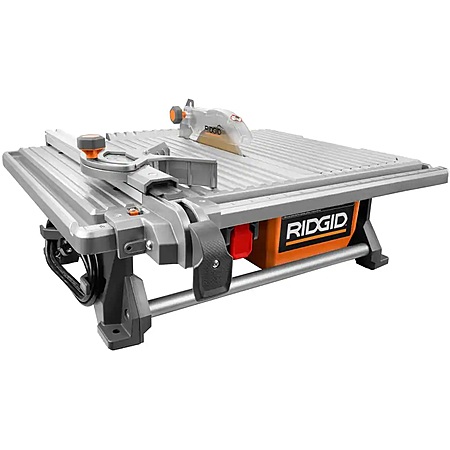
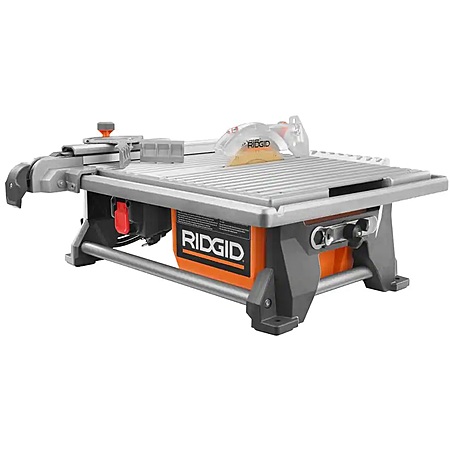
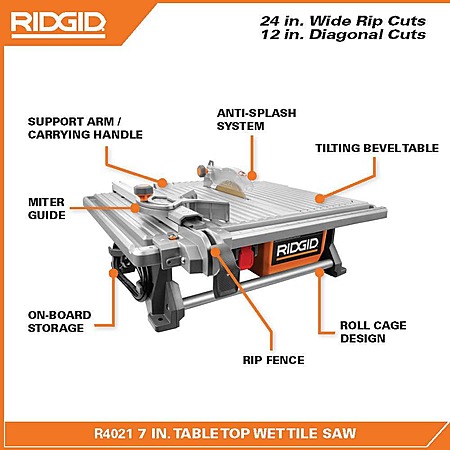
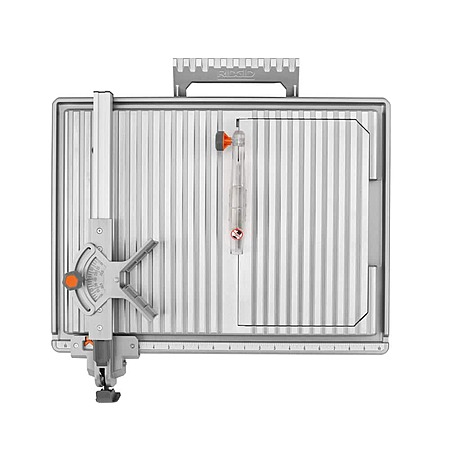
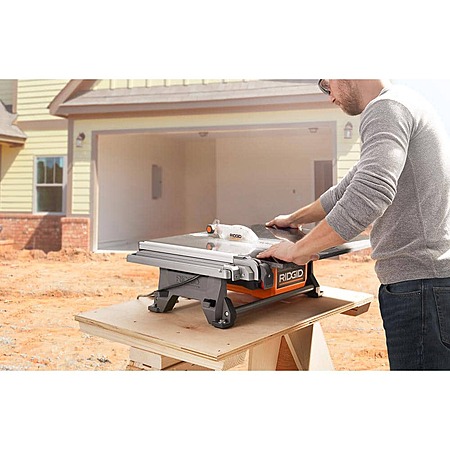





Leave a Comment
Top Comments
I personally have the Harbor Freight DiamondBack 7 in [harborfreight.com] one, because neither the comparable Ridgid [homedepot.com] nor the Kobalt [lowes.com] were in stock locally at the time and struggling on my previous little fixed table 7" Skil was slowing us (waaayyy) down. I was skeptical about going with HF for something like this, but it actually turned out fine. I did have to adjust the wheels for alignment, and this was a crucial step that I think some people miss: I don't remember it being in the manual. Once done, perfectly square, perfectly smooth sliding action, and I'd never cut tile any other way again, especially not porcelain. Easy mitered cuts, even though it was porcelain. It even cut mesh backed glass mosaic tile for a waterfall accent perfectly. The blade the HF one came with was decent enough, even.
The Kobalt has some negative reviews to where I'm glad I went with the Diamondback, but it might be fine. The Ridgid is highly reviewed.
Yes, they all run around $350, which, yes, is more than double this. But if you're already doing tile enough to buy a saw, you're already spending a fair bit and need to consider tool investments in proportion to that: and it's an investment that can pay off in a single room if you're doing something like a floor to ceiling shower, in terms of the amount of time it saves, not to mention possibly helping make less bad cuts. With two people working, you can easily cut as fast as the mud and tile goes up with a good bridge saw, even for small spaces with a lot of cuts.
I really wish I had just bought the bridge saw the first time, even if the previous project the Skil was bought for was a smaller project (just a half bath floor) where the fixed table Skil was technically "enough" to get it done. So, lesson learned, sometimes you just need to buy the more expensive tool once, even if it seems like possible overkill, especially if it's work you'll likely be doing again.
For me, the biggest benefits of the manual way are that you can do it right where you're working without spraying water and tile dust everywhere and you don't have to don PPE for every cut.
35 Comments
Sign up for a Slickdeals account to remove this ad.
https://www.lowes.com/pd/Kobalt-7...1000760324
https://www.lowes.com/pd/Kobalt-7...1000760324
https://www.lowes.com/pd/Kobalt-7...1000760324
I ended up with a porter cable sliding deck and like it a lot.
Sign up for a Slickdeals account to remove this ad.
Our community has rated this post as helpful. If you agree, why not thank taswyn
I personally have the Harbor Freight DiamondBack 7 in [harborfreight.com] one, because neither the comparable Ridgid [homedepot.com] nor the Kobalt [lowes.com] were in stock locally at the time and struggling on my previous little fixed table 7" Skil was slowing us (waaayyy) down. I was skeptical about going with HF for something like this, but it actually turned out fine. I did have to adjust the wheels for alignment, and this was a crucial step that I think some people miss: I don't remember it being in the manual. Once done, perfectly square, perfectly smooth sliding action, and I'd never cut tile any other way again, especially not porcelain. Easy mitered cuts, even though it was porcelain. It even cut mesh backed glass mosaic tile for a waterfall accent perfectly. The blade the HF one came with was decent enough, even.
The Kobalt has some negative reviews to where I'm glad I went with the Diamondback, but it might be fine. The Ridgid is highly reviewed.
Yes, they all run around $350, which, yes, is more than double this. But if you're already doing tile enough to buy a saw, you're already spending a fair bit and need to consider tool investments in proportion to that: and it's an investment that can pay off in a single room if you're doing something like a floor to ceiling shower, in terms of the amount of time it saves, not to mention possibly helping make less bad cuts. With two people working, you can easily cut as fast as the mud and tile goes up with a good bridge saw, even for small spaces with a lot of cuts.
I really wish I had just bought the bridge saw the first time, even if the previous project the Skil was bought for was a smaller project (just a half bath floor) where the fixed table Skil was technically "enough" to get it done. So, lesson learned, sometimes you just need to buy the more expensive tool once, even if it seems like possible overkill, especially if it's work you'll likely be doing again.
I personally have the Harbor Freight DiamondBack 7 in [harborfreight.com] one, because neither the comparable Ridgid [homedepot.com] nor the Kobalt [lowes.com] were in stock locally at the time and struggling on my previous little fixed table 7" Skil was slowing us (waaayyy) down. I was skeptical about going with HF for something like this, but it actually turned out fine. I did have to adjust the wheels for alignment, and this was a crucial step that I think some people miss: I don't remember it being in the manual. Once done, perfectly square, perfectly smooth sliding action, and I'd never cut tile any other way again, especially not porcelain. Easy mitered cuts, even though it was porcelain. It even cut mesh backed glass mosaic tile for a waterfall accent perfectly. The blade the HF one came with was decent enough, even.
The Kobalt has some negative reviews to where I'm glad I went with the Diamondback, but it might be fine. The Ridgid is highly reviewed.
Yes, they all run around $350, which, yes, is more than double this. But if you're already doing tile enough to buy a saw, you're already spending a fair bit and need to consider tool investments in proportion to that: and it's an investment that can pay off in a single room if you're doing something like a floor to ceiling shower, in terms of the amount of time it saves, not to mention possibly helping make less bad cuts. With two people working, you can easily cut as fast as the mud and tile goes up with a good bridge saw, even for small spaces with a lot of cuts.
I really wish I had just bought the bridge saw the first time, even if the previous project the Skil was bought for was a smaller project (just a half bath floor) where the fixed table Skil was technically "enough" to get it done. So, lesson learned, sometimes you just need to buy the more expensive tool once, even if it seems like possible overkill, especially if it's work you'll likely be doing again.
For me, the biggest benefits of the manual way are that you can do it right where you're working without spraying water and tile dust everywhere and you don't have to don PPE for every cut.
For me, the biggest benefits of the manual way are that you can do it right where you're working without spraying water and tile dust everywhere and you don't have to don PPE for every cut.
The point is, there are many ways to get the job done. Having done many tile jobs at this point, I don't ever see myself needing a huge sliding-table saw that takes up 5x the space while it's sitting around most of the time.
For me, the biggest benefits of the manual way are that you can do it right where you're working without spraying water and tile dust everywhere and you don't have to don PPE for every cut.
Sign up for a Slickdeals account to remove this ad.
For me, the biggest benefits of the manual way are that you can do it right where you're working without spraying water and tile dust everywhere and you don't have to don PPE for every cut.
Leave a Comment